20 Common Types of Sparrows in Florida (With Pictures)
Last Updated on
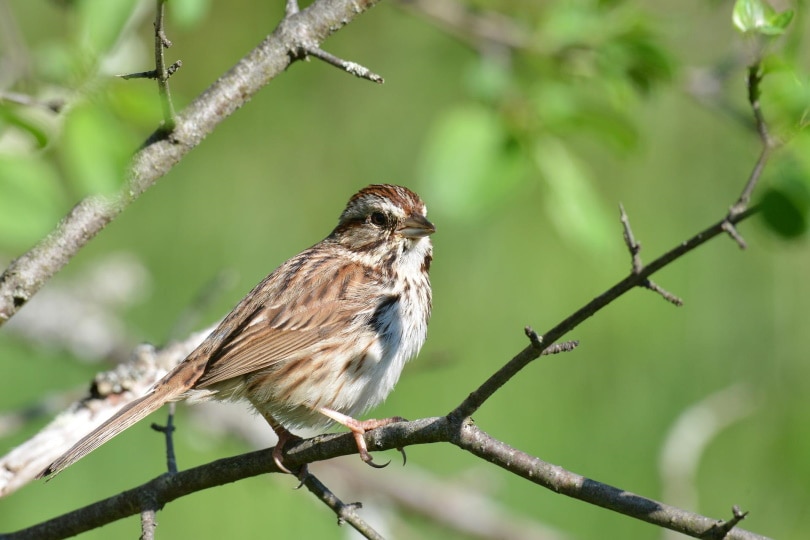
In the southeast corner of the U.S, Florida stands out with its geography and lush, tropical environment. There are endless opportunities to experience wildlife from afar, especially birding. There are many species of birds that are worth searching for, including sparrows.
In this article, we will be discussing more than a dozen common types of sparrows in the Sunshine State and their respective traits. Read below, and you’ll have a ton of new bird species to learn about!

The 20 Common Types of Sparrows in Florida
1. Song Sparrow
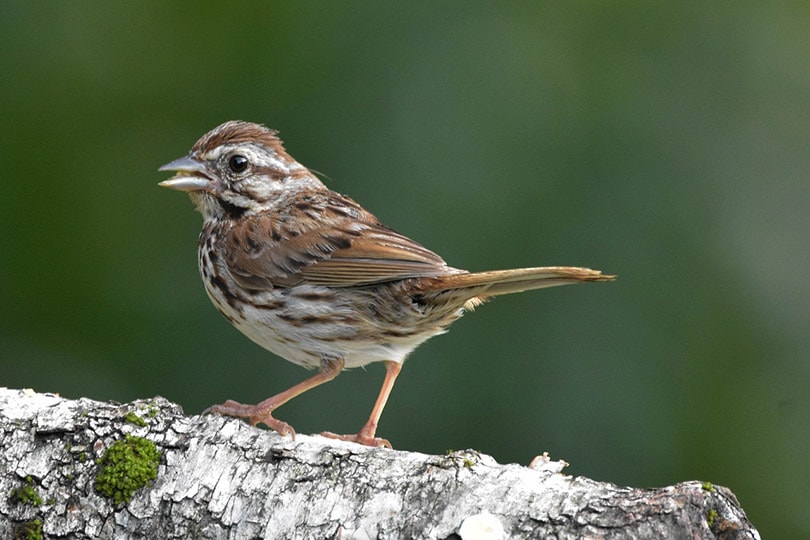
| Scientific name: | Melospiza melodia |
| Family: | Passerellidae |
| Endangerment: | Stable |
Our first common sparrow species is the song sparrow. This small, brown, and white bird is frequently seen in open areas with wet vegetation or dispersed trees. They have a similar physique to others, like the field sparrow or fox sparrow, but they have a much darker complexion that stands out from the rest. Song sparrows can be found in most places throughout Florida’s ecosystem, but they only visit after migrating from the north during the winter.
2. Field Sparrow

| Scientific name: | Spizella pusilla |
| Family: | Passerellidae |
| Endangerment: | Unstable |
Another extremely common small bird is the field sparrow. These insect-eating machines live in short, bushy habitats that have plenty of shelter from the elements. Field sparrows are brown and white, with a distinct underbelly that puffs out. They may live during all seasons near the border to Georgia, but if not, they are a winter guest. Although ground foragers, these birds are easy to tame at the feeder when given seeds.
3. Fox Sparrow

| Scientific name: | Passerella iliaca |
| Family: | Passerellidae |
| Endangerment: | Stable |
Getting its name from the reddish hues of a fox, this sparrow is a very common sight around the states. Florida residents may be able to see a fox sparrow for themselves, but only near the border between Georgia and Alabama. Fox sparrows mainly eat a carnivorous diet, but they may be enticed to feed on grains at the feeder. They can be found in dense forests where their food is plentiful, and shelter is easy to come by, but they can be seen in more urbanized areas as well.
4. Grasshopper Sparrow

| Scientific name: | Ammodramus savannarum |
| Family: | Passerellidae |
| Endangerment: | Unstable |
Found everywhere in the Sunshine State, the grasshopper sparrow has a lightly-colored body with a few tiny blotches of yellow near the top of the eyes and the tips of the wings. For the most part, grasshopper sparrows are migratory and come down to the south for winter. However, there are some populations that live year-round. They nest in wet grassland areas with lots of insects roaming beneath the stalks. They can be a challenge to search for, but it’s best to listen for buzzy calls if you want to identify them from afar.
5. White-crowned Sparrow

| Scientific name: | Zonotrichia leucophrys |
| Family: | Passerellidae |
| Endangerment: | Stable |
The white-crowned sparrow has a mix of white, gray, brown, and black (males only) tones on display. This species lives in the state in a few select areas during the winter season, like central Florida and across the panhandle in the northwest. Living in scrubs and bushes, this bird eats a diet of insects and bugs that can be found near the ground. They do like seeds and grains though, so it shouldn’t be difficult to attract them to your backyard.
6. Vesper Sparrow

| Scientific name: | Pooecetes gramineus |
| Family: | Passerellidae |
| Endangerment: | Stable |
The brown and white vesper sparrow is a winter resident of Florida that lives in all regions of the state. Designated in grassy habitats, the vesper sparrow is frequently heard as the sun sets. This species is known for its bright tail feathers in flight and chestnut-colored spots near the shoulders. Vesper sparrows eat mainly insects found in fields and pastures but they may eat grains if desired.
7. Henslow’s Sparrow

| Scientific name: | Centronyx henslowii |
| Family: | Passerellidae |
| Endangerment: | Unstable |
Henslow’s sparrows are masked with white, black, and beige stripes on their forehead, along with a faint, yellow head. They make extremely brief calls, which can be heard at dusk and dawn in open, grassy areas in the eastern U.S. In Florida, Henslow’s sparrows live across the state when it gets too cold to stay in the north. However, it’s best to search for them in marshland ecosystems while they scavenge for food on the ground.
8. Savannah Sparrow
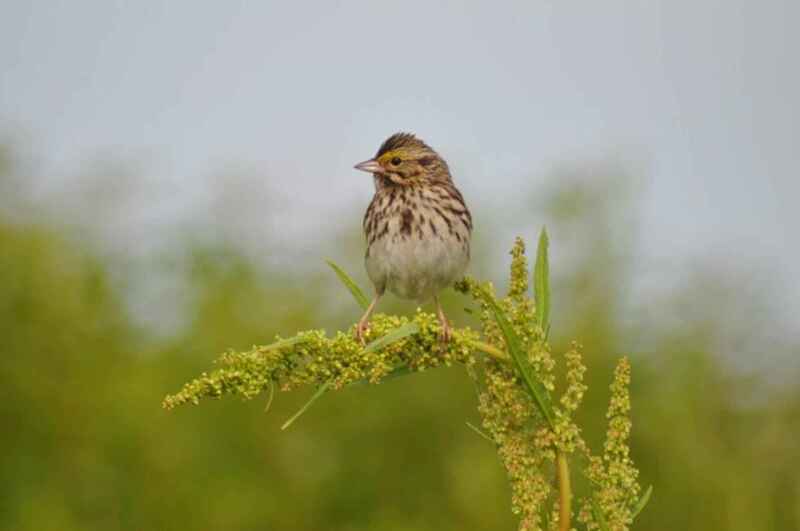
| Scientific name: | Passerculus sandwichensis |
| Family: | Passerellidae |
| Endangerment: | Stable |
The savannah sparrow looks quite similar to Henslow’s sparrow, with the same color patterns along the head and body. The best way to identify a savannah sparrow is by looking under its eye. You should see a series of small, lightly-colored feathers rather than the Henslows’ blackish streak. Savannah sparrows are named after their domain in Savannah, Georgia, as they live in the southeast’s warm, grassy climate.
9. Eastern Towhee
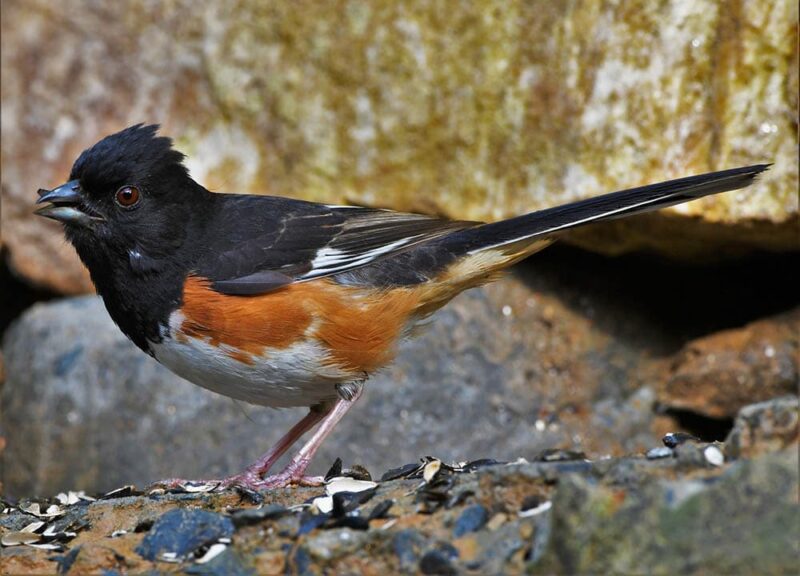
| Scientific name: | Pipilo erythrophthalmus |
| Family: | Passerellidae |
| Endangerment: | Stable |
The eastern towhee is a bit different from the other sparrows that we’ve mentioned. This red-eyed bird is hooded in black (male) or brown (female), with a white underbelly and an orange patch just below the wings. Unlike the above species, the eastern towhee is a year-round resident in Florida, found in every corner of the state. Eastern towhees are omnivorous, eating a variety of foods that they find beneath the brush of bushes and scrubs. Keep in mind that this species can be easily mistaken for the spotted towhee, which lives in the western states. However, their domain in the east makes it unlikely for them to roam together.
10. Indigo Bunting
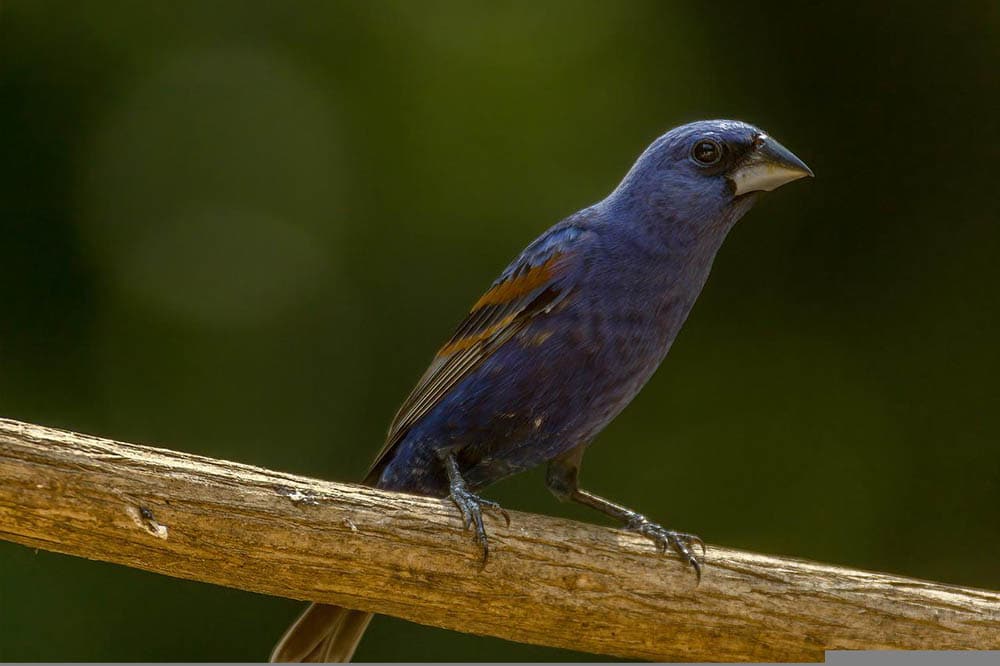
| Scientific name: | Passerina cyanea |
| Family: | Cardinalidae |
| Endangerment: | Stable |
This bird was named after the bright blue hues displayed by the male indigo bunting. Females are brown in color, but both males and females have streaky wings and gray beaks. Calling home to all areas of Florida, this species lives during mating season and has some migratory behavior. Nesting in bushes in the open woodland biome, indigo buntings search for leaf-foraging bugs and seedy foods.
11. Barn Swallow

| Scientific name: | Hirundo rustica |
| Family: | Hirundinidae |
| Endangerment: | Stable |
Barn swallows have a magnificent coloring of orange, yellow, and blue. Their scissor-like tail feathers are incredibly aerodynamic, which gives them great control in flight. Because of this feature, barn swallows are aerial foragers, catching flying insects that spring up from the grass. These birds live in all areas of the state but typically move down south and to the Caribbean after successfully breeding. Barn swallows are not easy to bring to your feeder, so it’s best to search in meadows or fields that are dense with grass and insects.
12. Saltmarsh Sparrow

| Scientific name: | Ammospiza caudacuta |
| Family: | Passerellidae |
| Endangerment: | Unstable |
Populations of the salt marsh sparrow are greatly reducing in numbers, but they can be found along the coast of Florida and other Atlantic states. This species has an upright body with a brownish-white coloring, in addition to a yellowish face. Similar to many other sparrows, the salt marsh variation is a habitual ground forager that scans the dirt for crawling insects. As the name suggests, they live in marshes and grasslands that are close to the ocean.
13. Chipping Sparrow

| Scientific name: | Spizella passerina |
| Family: | Passerellidae |
| Endangerment: | Stable |
The best way to identify a chipping sparrow is to look for a bird with a white underbelly, goldish-brown wings, and a deep-orange cap if it’s a male. Chipping sparrows typically live here for warmth in the winter months, but they can be seen in the northwest during extended periods. An open-woodland dweller, the chipping sparrow is fond of seeds and grains; they can be attracted to feeders if in the right location.
14. Seaside Sparrow

| Scientific name: | Ammospiza maritima |
| Family: | Passerellidae |
| Endangerment: | Unstable |
As indicated by the name, this sparrow stays close to the coastlines of Florida and other southeastern states bordering the Atlantic. The seaside sparrow is found year-round in the northwestern marshes of Florida, whereas their eastern domain is most popular during the springtime for breeding. You’ll notice that the seaside sparrow has a small yellow patch above the eye, similar to some of the previous species we’ve discussed. The rest of its body is a mix of brown and gray shades.
15. LeConte’s Sparrow

| Scientific name: | Ammospiza leconteii |
| Family: | Passerellidae |
| Endangerment: | Unstable |
A bird consisting of light-colored feathers, the LeConte’s sparrow is a resident in the Sunshine State’s northwestern panhandle. Here, they nest among the wet grassland vegetation and forage for invertebrates to feed their young. As they stay hidden the majority of the time, it can be difficult to spot them out in the open. However, their winter spots in Florida make them a bit less shy.
16. Nelson’s Sparrow

| Scientific name: | Ammospiza nelsonii |
| Family: | Passerellidae |
| Endangerment: | Stable |
A brown bird of Florida marshes, Nelson’s sparrow has territory ranging from the top half of the state’s coastal borders in addition to some habitat in the southern tip. Nelson’s sparrows live here outside of breeding season and are natural ground foragers. The best places to search for these birds are wetland marshes and meadows with stalky grass. Here, you may be able to see them frolicking on the ground in search of crawling insects.
17. House Sparrow
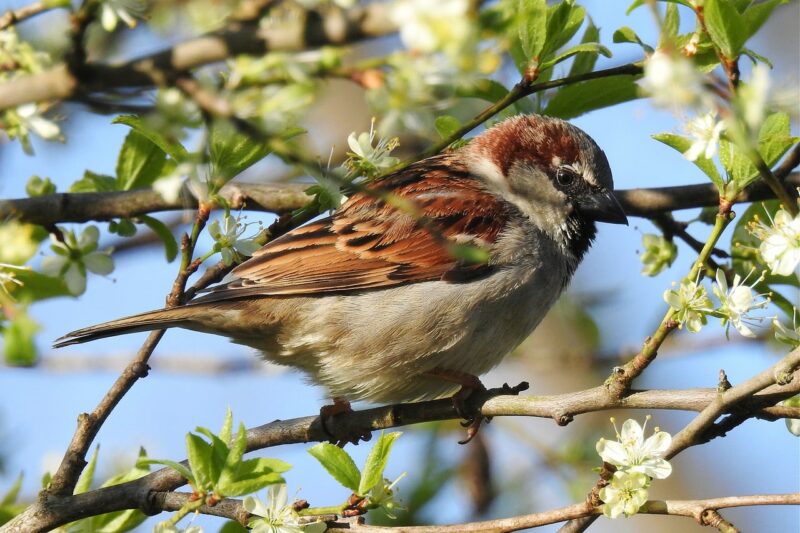
| Scientific name: | Passer domesticus |
| Family: | Passerellidae |
| Endangerment: | Stable |
One of the most frequently sighted birds on the continent, the house sparrow is a familiar face, covered in a brown coat. Beware, though; this little bugger can be a hassle if you want to attract other birds to the feeder. House sparrows have invaded many habitats, including towns and homes. You won’t have trouble finding them throughout all times of year in all regions of the state.
18. Dark-eyed Junco
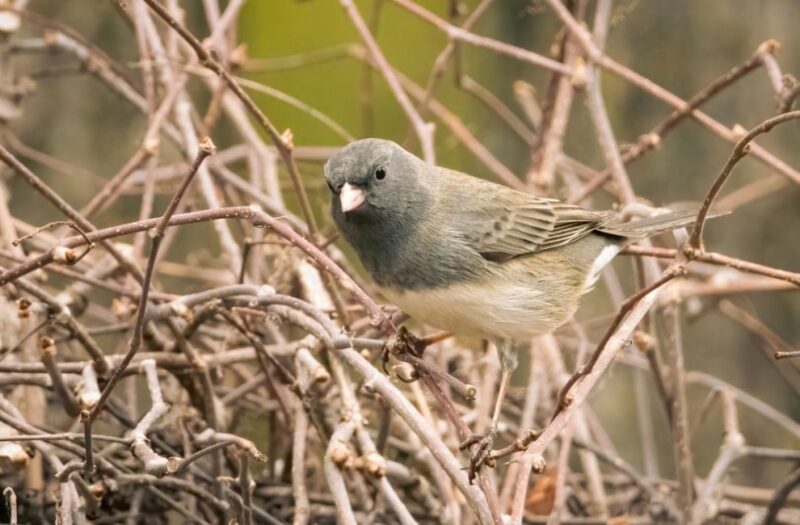
| Scientific name: | Junco hyemalis |
| Family: | Passerellidae |
| Endangerment: | Stable |
Dark-eyed juncos can be seen flying and perching among thick forests with their half-gray-half-white plumage on display. While they do live in woodland areas, they tend to be active close to the ground so they have quick access to seeds and fruit-bearing plants. Find the dark-eyed junco in northern Florida during the winter or in some northern areas where they can be spotted year-round.
19. White-spotted Sparrow

| Scientific name: | Zonotrichia albicollis |
| Family: | Passerellidae |
| Endangerment: | Stable |
With bright yellow patches above the eyes, the white-spotted sparrow is a forest-dweller that loves to show off its brown coat and white-spotted throat. Found during non-breeding seasons, this species has a knack for gathering seeds while inspecting the forest floor; a true feeder-magnet! Do note that they do not always come with a yellow, black, and white cap. Instead, they may form a spin of light and dark brown shades.
20. Swamp Sparrow
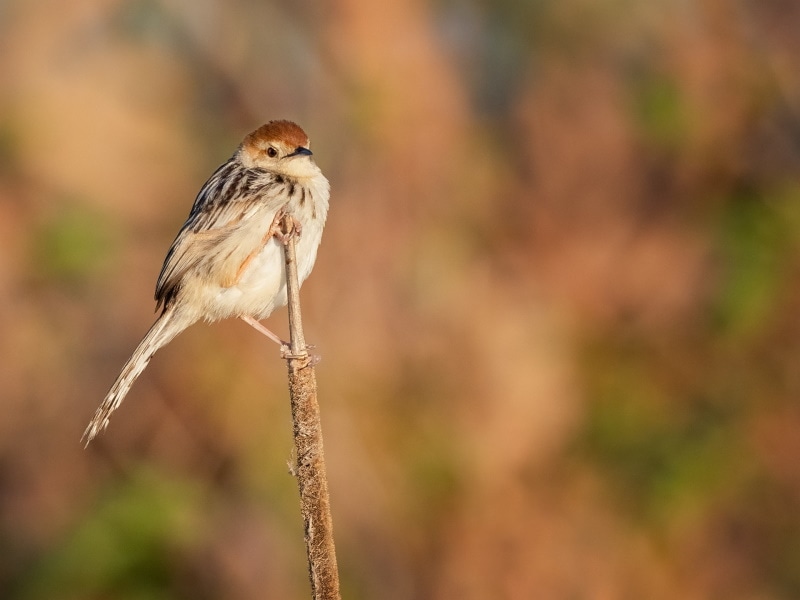
| Scientific name: | Melospiza georgiana |
| Family: | Passerellidae |
| Endangerment: | Stable |
In the top half of Florida’s land area, the swamp sparrow lives both inland and near the ocean. Look in low-lying vegetation situated in marshes or meadows for a chance to see their nesting grounds. Like many of its kind, the swamp sparrow has a mixed plumage of brown, white, and tan. Your best luck in finding this species is during the mating off-season, and it’s possible to see them migrate to the north when the time comes.

Final Thoughts
Home to many sparrow species, Florida’s wet, tropical climate is the perfect place for these birds to roam free. Whether inland or close to the Atlantic and Gulf of Mexico, you can see a variety of small sparrows outside of mating season. Although many on our list have similar physical traits, our guide of 20 common types of sparrows in Florida should give you the upper hand on the trails.
See also:
Featured Image Credit: u_z4q28nbq, Pixabay
Table of Contents
- The 20 Common Types of Sparrows in Florida
- 1. Song Sparrow
- 2. Field Sparrow
- 3. Fox Sparrow
- 4. Grasshopper Sparrow
- 5. White-crowned Sparrow
- 6. Vesper Sparrow
- 7. Henslow’s Sparrow
- 8. Savannah Sparrow
- 9. Eastern Towhee
- 10. Indigo Bunting
- 11. Barn Swallow
- 12. Saltmarsh Sparrow
- 13. Chipping Sparrow
- 14. Seaside Sparrow
- 15. LeConte’s Sparrow
- 16. Nelson’s Sparrow
- 17. House Sparrow
- 18. Dark-eyed Junco
- 19. White-spotted Sparrow
- 20. Swamp Sparrow
- Final Thoughts
About the Author Robert Sparks
Robert’s obsession with all things optical started early in life, when his optician father would bring home prototypes for Robert to play with. Nowadays, Robert is dedicated to helping others find the right optics for their needs. His hobbies include astronomy, astrophysics, and model building. Originally from Newark, NJ, he resides in Santa Fe, New Mexico, where the nighttime skies are filled with glittering stars.
Related Articles:
Monocular vs Telescope: Differences Explained (With Pictures)
10 Types of Hummingbirds in Arkansas (With Pictures)
8 Types of Hummingbirds in Nebraska (With Pictures)
5 Types of Hummingbirds in Idaho (With Pictures)
3 Types of Hummingbirds in Mississippi (With Pictures)
8 Types of Hummingbirds in Kansas (With Pictures)
5 Types of Hummingbirds in West Virginia (With Pictures)
5 Types of Hummingbirds in Ohio (With Pictures)
